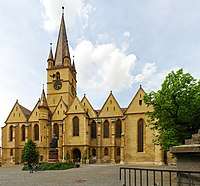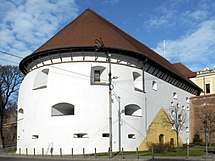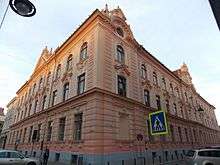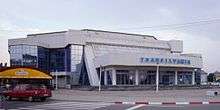Sibiu
Sibiu (/siːˈbjuː/ see-BEW,[5] Romanian: [siˈbiw], German: Hermannstadt [ˈhɛʁmanʃtat], Hungarian: Nagyszeben [ˈnɒcsɛbɛn]) is a city in Transylvania, a historical region of Romania. Located some 275 km (171 mi) north-west of Bucharest,[6] the city straddles the Cibin River, a tributary of the river Olt. Now the capital of the Sibiu County, between 1692 and 1791 and 1849–65 Sibiu was also the capital of the Principality of Transylvania.
Sibiu Hermannstadt | |
|---|---|
.png) From top, left to right: Council Tower (city symbol) • Lutheran Cathedral • Eyes of Sibiu • Medieval fortifications • Bridge of Lies • City hall and Jesuit Church • Brukenthal Palace • Neo-Baroque palace • Modern high-rise buildings | |
 Flag  Coat of arms | |
| Nickname(s): | |
 Sibiu Location within Romania | |
| Coordinates: 45°47′34″N 24°09′07″E | |
| Country | |
| County | |
| Status | Municipiu |
| Settled | 1st century BC |
| Resettled | c. 1147 |
| First off. record | 1191 (as Cibinium) |
| Government | |
| • Mayor | Astrid Fodor[4] (FDGR) |
| Area | |
| • City | 121 km2 (47 sq mi) |
| Elevation | 415 m (1,362 ft) |
| Population (2011) | |
| • City | 147,245 |
| • Estimate (2019) | 169,056 |
| • Density | 1,200/km2 (3,200/sq mi) |
| • Metro a | 267,170 |
| Demonym(s) | sibian, sibiancă (ro) |
| Time zone | UTC+2 (EET) |
| • Summer (DST) | UTC+3 (EEST) |
| Area code(s) | +40 269/369 |
| Car plates | SB |
| Website | www |
| aSibiu metropolitan area is a proposed project | |
Nicknamed The City with Eyes or Seebiu, the city is a well-known tourist destination for both domestic and foreign visitors. Known for its culture, history, gastronomy and its diverse architecture, which includes its much iconic houses with eyes that gave Sibiu its nickname, the city has been getting much attention since the beginning of the 21st century. In 2004, its historical center has begun the process of becoming a UNESCO World Heritage Site. Sibiu was designated the European Capital of Culture in 2007.[7] One year later, it was ranked "Europe's 8th-most idyllic place to live" by Forbes.[8] In 2019, Sibiu was named the European Region of Gastronomy,[9] while in 2020 it was designated "Europe's sixth best tourist destination".[10] Sibiu will host the European Wandering Capital event in 2021, the most important tourist wandering event in Europe.[11][12] A European Union summit was hosted by the city in 2019.
Sibiu is also known for its Christmas market.[13][14] The pioneers of rocketry Conrad Haas and Hermann Oberth were from Sibiu.[15]
As of 2011, the city has a population of 147,245,[16] while a 2019 estimate puts it at 169,056.[17] The proposed Sibiu metropolitan area has a population of 267,170. The city also administers the village of Păltiniș, a ski resort located 35 kilometres to the south.
Historically, Sibiu has been one of the most important centres of the Transylvanian Saxons. It is called Härmeschtat in their dialect.[18]
Name
The Romanian name Sibiu derives from the city's Latin name of Cibinium,[19] which is also the source of the Cibin river's name. An archaic version of the name is Sibiiu, while an obsolete folk name is Sâghii, also spelled Sîghii.
In German, it is called Hermannstadt ("Hermann's city"), while in the local Transylvanian Saxon dialect, it is known as Härmeschtat. Its Hungarian name is Nagyszeben ("Big/Greater Sibiu"), or colloquially, Szeben. In Yiddish, it is called סעבען Seben or הערמאנשטאט Hermanshtat.
A number of other languages also have their own variants of the city's name, like Czech Sibiň, Polish Sybin, Serbo-Croatian Sibinj and the proposed Esperanto name of Sibio.
History
Sibiu was initially a Daco-Roman city called Cedonia.[20] The town was refounded by Saxon (German) settlers brought there by king Géza II of Hungary. They came from territories of the Holy Roman Empire and Kingdom of France (nowadays parts of Germany, France and the Benelux countries) and arrived at around 1147.[21][22] The first references to the area were Cibinium and Cipin from 1191 when Pope Celestine III confirmed the existence of the free prepositure of the Saxons in Transylvania, having its headquarters in Sibiu.[23][24] The city also used the names Prepositus Cibiniensis (1192-1196) and Prepositus Scibiniensis (1211). In 1223, it was renamed to Villa Hermanni,[25] either in honor of archbishop Hermann II of Cologne[21] or after a man who is believed to have founded the city, Hermann of Nuremberg.[25] The actual German name of Hermannstadt ("Hermann's city") dates from 1366, while an earlier form, Hermannsdorf ("Hermann's village") was recorded in 1321.[26]
In the 14th century, it was already an important trade centre. In 1376, the craftsmen were divided in 19 guilds. Sibiu became the most important ethnic German city among the seven cities that gave Transylvania its German name Siebenbürgen (literally seven citadels).[27][28] It was home to the Universitas Saxorum (Community of the Saxons), a network of pedagogues, ministers, intellectuals, city officials, and councilmen of the German community forging an ordered legal corpus and political system in Transylvania since the 1400s.[29][30] In 1699, after the Ottomans withdrew to their base of power in Hungary and Transylvania, the town became capital of Principality of Transylvania (since 1570 the principality was mostly under suzerainty of the Ottoman Empire, however often had a dual vassalage).[31] During the 18th and 19th centuries, the city became the second- and later the first-most important centre of Transylvanian Romanian ethnics. The first Romanian-owned bank had its headquarters here (The Albina Bank), as did the ASTRA (Transylvanian Association for Romanian Literature and Romanian's People Culture). After the Romanian Orthodox Church was granted status in the Austrian Empire from the 1860s onwards, Sibiu became the Metropolitan seat, and the city is still regarded as the third-most important centre of the Romanian Orthodox Church. Between the Hungarian Revolution of 1848 and 1867 (the year of the Ausgleich), Sibiu was the meeting-place of the Transylvanian Diet, which had taken its most representative form after the Empire agreed to extend voting rights in the region.
After World War I, when Austria-Hungary was dissolved, Sibiu became part of Romania; the majority of its population was still ethnic German (until 1941) and counted a large Romanian community, as well as a smaller Hungarian one. Starting from the 1950s and until after 1990, most of the city's ethnic Germans emigrated to Germany and Austria. Among the roughly 2,000 who have remained is Klaus Johannis, the current President of Romania.
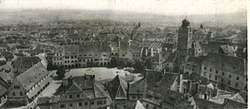 Panoramic view of Sibiu from 1928
Panoramic view of Sibiu from 1928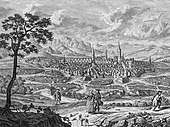 View from Gușterița hill
View from Gușterița hill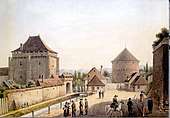 Burger-Ocnei gate
Burger-Ocnei gate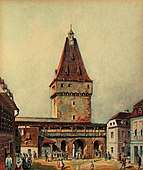 Cisnădie's Gate Tower
Cisnădie's Gate Tower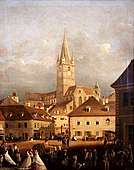 Tower's Street and the Evangelical Lutheran Church
Tower's Street and the Evangelical Lutheran Church%2C_17th_century_engraving.jpg) Copper engraving of Sibiu (Hermanstatt), c. 1630.
Copper engraving of Sibiu (Hermanstatt), c. 1630. A busy market scene in Sibiu, 1818
A busy market scene in Sibiu, 1818
Geography

Sibiu is situated near the geographical center of Romania at 45.792784°N 24.152069°E. Set in the Cibin Depression, the city is about 20 km from the Făgăraș Mountains, 12 km from the Cibin Mountains, and about 15 km from the Lotru Mountains, which border the depression in its southwestern section. The northern and eastern limits of Sibiu are formed by the Târnavelor Plateau, which descends to the Cibin Valley through Gușteriței Hill.
The Cibin river as well as some smaller streams runs through Sibiu. The geographical position of Sibiu makes it one of the most important transportation hubs in Romania with important roads and railway lines passing through it.
Climate
Sibiu's climate is humid continental (Köppen: Dfb), although considering the original −3 °C (27 °F) isotherm, it borders a humid subtropical type (Cfa), with average temperatures of 8 to 9 °C (46 to 48 °F). The average rainfall is 627 litres per square metre (12.8 imp gal/sq ft), and there are about 120 days of hard frost annually.
| Climate data for Sibiu (1981–2010) | |||||||||||||
|---|---|---|---|---|---|---|---|---|---|---|---|---|---|
| Month | Jan | Feb | Mar | Apr | May | Jun | Jul | Aug | Sep | Oct | Nov | Dec | Year |
| Record high °C (°F) | 15.6 (60.1) |
21.3 (70.3) |
30.6 (87.1) |
30.2 (86.4) |
32.1 (89.8) |
35.4 (95.7) |
38.3 (100.9) |
38.4 (101.1) |
39.5 (103.1) |
32.5 (90.5) |
27.0 (80.6) |
19.3 (66.7) |
39.5 (103.1) |
| Average high °C (°F) | 1.8 (35.2) |
4.5 (40.1) |
10.1 (50.2) |
16.0 (60.8) |
21.3 (70.3) |
24.2 (75.6) |
26.3 (79.3) |
26.2 (79.2) |
21.4 (70.5) |
16.2 (61.2) |
9.1 (48.4) |
3.1 (37.6) |
15.0 (59.0) |
| Daily mean °C (°F) | −2.8 (27.0) |
−1.2 (29.8) |
3.8 (38.8) |
9.6 (49.3) |
14.9 (58.8) |
18.0 (64.4) |
19.7 (67.5) |
19.1 (66.4) |
14.4 (57.9) |
9.1 (48.4) |
3.4 (38.1) |
−1.3 (29.7) |
8.9 (48.0) |
| Average low °C (°F) | −6.9 (19.6) |
−5.9 (21.4) |
−1.2 (29.8) |
3.9 (39.0) |
8.6 (47.5) |
11.6 (52.9) |
13.3 (55.9) |
12.7 (54.9) |
8.7 (47.7) |
3.5 (38.3) |
−1.2 (29.8) |
−5.3 (22.5) |
3.5 (38.3) |
| Record low °C (°F) | −31.8 (−25.2) |
−31.0 (−23.8) |
−24.5 (−12.1) |
−12.0 (10.4) |
−3.6 (25.5) |
1.0 (33.8) |
4.2 (39.6) |
1.0 (33.8) |
−3.6 (25.5) |
−9.4 (15.1) |
−21.3 (−6.3) |
−29.8 (−21.6) |
−31.8 (−25.2) |
| Average precipitation mm (inches) | 24.9 (0.98) |
25.0 (0.98) |
33.9 (1.33) |
52.8 (2.08) |
69.0 (2.72) |
92.9 (3.66) |
92.0 (3.62) |
76.7 (3.02) |
59.8 (2.35) |
39.9 (1.57) |
31.3 (1.23) |
31.0 (1.22) |
629.2 (24.77) |
| Average snowfall cm (inches) | 11.0 (4.3) |
11.0 (4.3) |
7.4 (2.9) |
4.8 (1.9) |
0.0 (0.0) |
0.0 (0.0) |
0.0 (0.0) |
0.0 (0.0) |
0.0 (0.0) |
1.7 (0.7) |
4.5 (1.8) |
6.5 (2.6) |
46.9 (18.5) |
| Average precipitation days (≥ 0.1 mm) | 11.2 | 10.5 | 11.2 | 13.1 | 15.2 | 14.5 | 13.3 | 10.4 | 10.6 | 9.0 | 9.7 | 12.1 | 140.8 |
| Average relative humidity (%) | 87 | 79 | 71 | 67 | 68 | 71 | 71 | 72 | 76 | 78 | 80 | 86 | 75 |
| Mean monthly sunshine hours | 68 | 97 | 138 | 164 | 215 | 228 | 248 | 238 | 172 | 148 | 89 | 61 | 1,866 |
| Source 1: World Meteorological Organization,[32] Ogimet (mean temperatures and sun 1981–2010)[33] | |||||||||||||
| Source 2: Romanian National Statistic Institute (extremes 1901–2000),[34] NOAA (snowfall 1961–1990),[35] Deutscher Wetterdienst (humidity, 1989–2008)[36] | |||||||||||||
Tourism
In 2007, Sibiu was the European Capital of Culture (together with Luxembourg). This was the most important cultural event that has ever happened in the city, and a great number of tourists came, both domestic and foreign.
The city of Sibiu and its surroundings are one of the most visited areas in Romania. It holds one of the best preserved historical sites in the country, many of its medieval fortifications having been kept in excellent state. Its old center has begun the process for becoming a UNESCO World Heritage Site in 2004. Sibiu and its surrounding area have many significant museums, with 12 institutions housing art collections, paintings, and exhibits in decorative arts, archeology, anthropology, history, industrial archeology and history of technology and natural sciences.
The city also lies close to the Făgăraș Mountains – a popular trekking destination, close to the Păltiniș and Arena Platos ski resorts – both winter holiday destinations, and it is at the heart of the former Saxon communities in Transylvania renowned for its fortified churches.
Since 2007, a traditional Christmas market has been held in Sibiu. The first of its kind in Romania, it is inspired by Viennese Christmas markets, being a project developed by the Social Attaché of the Austrian Embassy in Romania, dr.h.c. Barbara Schöfnagel It was held in the "Lesser Square" (Piața Mică) with 38 small stalls, a small stage and an area dedicated to children, having several mechanical attractions installed there. Since 2008 the market is held in the "Grand Square" and grew to a number of about 70 stalls, a bigger stage was set up, where Christmas carols concerts are held. An ice skating rink and a children's workshop are also attractions which have been added in the following years.[37] It was the first Christmas Market in Romania, but soon other Christmas markets emerged across the country. In 2013, the Sibiu Christmas markets was included in the "15 Of the Most Beautiful Christmas Markets in Europe"[38]
In 2019 Sibiu will host the European Gastronomical capital, by encouraging the local producers and local businesses in the field of food production and culinary culture, traditional gourmet workshops in the villages of the region, promoting peasant farms and gastronomic circuits, or developing public programs to support small producers in gastronomy and of the hospitality industry in the Sibiu region.[9]
Main sights
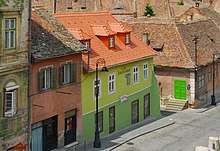
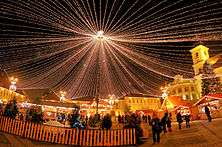
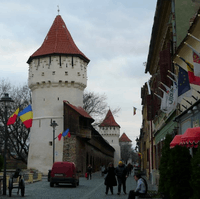

Much of the city's aspect is due to its position, easily defensible, but allowing horizontal development. The old city of Sibiu lies on the right bank of the Cibin River, on a hill situated at about 200 m from the river. It consists of two distinct entities: the Upper Town and the Lower Town. Traditionally, the Upper Town was the wealthier part and commercial outlet, while the Lower Town served as the manufacturing area.
The Lower Town
(German: Unterstadt, Romanian: Orașul de jos) comprises the area between the river and the hill, and it developed around the earliest fortifications. The streets are long and quite wide for medieval city standards, with small city squares at places. The architecture is rather rustic: typically two-storey houses with tall roofs and gates opening passages to inner courts.
Most of the exterior fortifications were lost to industrial development and modern urban planning in the mid-late 19th century; only four towers still exist. A building associated with newer urbanism of the period is the Independența Highschool.
This area has the oldest church in the city – in fact the first mention of the city itself is the reconfirmation of the local provostship as praepositum Cibiniensem – that was the religious center of the Saxons until the 15th century.[39] Whilst the Church between the Fir trees dates back to 1778.
The Upper Town (German: Oberstadt, Romanian: Orașul de sus) is organised around three city squares and a set of streets along the line of the hill. As the main area for burgher activities, the area contains most points of interest in the city.
Grand Square
(German: Großer Ring, Romanian: Piața Mare ) is, as its name suggests, the largest square of the city, and has been the center of the city since the 15th century. At 142 meters long and 93 meters wide, it is one of the largest ones in Transylvania.
Brukenthal Palace, one of the most important Baroque monuments in Romania, lies on the north-western corner of the square. It was erected between 1777 and 1787 as the main residence for the Governor of Transylvania Samuel von Brukenthal. It houses the main part of the National Brukenthal Museum, opened in 1817, making it one of the oldest museums in the world. Next to the palace is the Blue House or Moringer House, an 18th-century Baroque house bearing the old coat of arms of Sibiu on its façade.
.jpg)
On the north side is the Jesuit Church, along with its dependencies, the former residence of the Jesuits in Sibiu. Also on the north side, at the beginning of the 20th century an Art Nouveau building was constructed on the west part, now it houses the mayor's office.
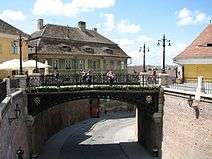
Next to the Jesuit Church on the north side is the Council Tower, the city's symbol. This former fortification tower from the 13th century has been successively rebuilt over the years. The building nearby used to be the City Council's meeting place; beneath it lies an access way between the Grand Square and the Lesser Square.
On the south and east sides are two- or three-storey houses, having tall attics with small windows known as the city's eyes. Most of these houses are dated 15th to 19th centuries, and most of them are Renaissance or Baroque in style.
Lesser Square (Small Square, German: Kleiner Ring) as its name implies, is a smaller square situated in the northern part of the Upper Town. After the 2007 rehabilitation there has been an increase in the number of small businesses such as pubs and restaurants in this area.
The square is connected to the other two squares and to other streets by small, narrow passages. The main access from the Lower City is through Ocnei Street, which divides the square in two. The street passes under the Bridge of Lies – the first bridge in Romania to have been cast in iron (1859).[40]
To the right of the bridge is another symbol of the city, The House of the Arts, a 14th-century arched building formerly belonging to the Butchers' Guild. On the left side of the bridge is the Luxemburg House, a Baroque four-storey building.
Huet Square is the third of the three main squares of Sibiu. Its most notable feature is the Evangelical Lutheran Cathedral in its center. It is the place where the earliest fortifications have been built in the late 12th century or early 13th century. The buildings around this square are mainly Gothic. On the west side lies the Brukenthal Highschool, in place of a former 14th-century school.
The Fortifications of Sibiu made the city one of the most important fortified cities in Central Europe. Multiple rings were built around the city, most of them out of clay bricks. The south-eastern fortifications are the best kept, and all three parallel lines are still visible. The first is an exterior earth mound, the second is a 10-meter-tall red brick wall, and the third line comprises towers linked by another 10-meter-tall wall. All structures are connected via a labyrinth of tunnels and passageways, designed to ensure transport between the city and lines of defense.
In the 16th century more modern elements were added to the fortifications, mainly leaf-shaped bastions. Two of these survived to this day, as the Haller Bastion (all the way down Coposu Boulevard) and "Soldisch Bastion".
The Passage of the Stairs, leads down to the lower section of Sibiu. It descends along some fortifications under the support arches. It is one of several passages linking the two sides of the old city.
Culture
Sibiu is one of Romania's most culturally lively cities. It has 2 theatres and a philharmonic orchestra along with other smaller private theatrical venues and a theatre studio housed by the Performing Arts and Acting section of Lucian Blaga University, where students hold monthly representations.
The Radu Stanca National Theatre[41] is one of the leading Romanian theatres. With origins dating back to 1787, it attracts some of the best-known Romanian directors, such as Gábor Tompa and Silviu Purcărete. It has both a Romanian-language and a German-language section, and presents an average of five shows a week.
The Gong Theatre is specialised in puppetry, mime and non-conventional shows for children and teenagers. It also presents shows in both Romanian and German.
The State Philharmonic of Sibiu[42] presents weekly classical music concerts, and educational concerts for children and teenagers. The concerts take place in the newly restored Thalia Hall, a concert and theatre hall dating from 1787, situated along the old city fortifications. Weekly organ concerts are organised at the Evangelical Cathedral during summers, and thematic concerts are presented by the Faculty of Theology choir at the Orthodox Cathedral.
The Sibiu International Theatre Festival is an annual festival of performing arts. Since 2016, it is the largest performance arts festival in the world.[43]
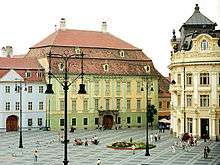
Museums and parks
Sibiu's museums are organised around two entities: the Brukenthal National Museum and the ASTRA National Museum Complex. The Brukenthal Museum consists of an Art Gallery and an Old Books Library located inside the Brukenthal Palace, a History Museum located in the old town hall building, a Pharmacy Museum located in one of the first apothecary shops in Europe, dating from the 16th century, a Natural History Museum and a Museum of Arms and Hunting Trophies.
The ASTRA National Museum Complex focuses on ethnography, and consists of a Traditional Folk Civilisation Museum, a 96-hectare open-air museum located in Dumbrava Forest south of Sibiu, a Universal Ethnography Museum, a Museum of Transylvanian Civilisation and a Museum of Saxon Ethnography and Folk Art. Also planned is a Museum of the Culture and Civilisation of the Romany People.
The Dumbrava Sibiului Natural Park stretches over 960 hectares and it is situated 4 km away from the center of the city in the southwest direction along the road towards Răşinari. Also, here you can find the Zoological Garden and Ethnography Museum.
There is a Steam Locomotives Museum close to the railway station, sheltering around 40 locomotives, two of which are functional.
The first park in the city was The Promenade, later called "The Disabled Promenade." established in 1791, today part of Parcul Cetății (Citadel Park). Current arrangement of the park, including the space between the walls, dates from 1928.
The Sub Arini Park, established between 1857 and 1859 based on plans of military engineer Michael Seyfried,[44] is one of the biggest and best-maintained parks in Romania. There are other green spaces in the city center, the best known being Astra Park, established in 1879.
Other parks:
Tineretului Park, Reconstrucției Park, Corneliu Coposu Park, Petöfi Sándor Park, Piața Cluj Park, Ștrand Park, Cristianului Park, Țițeica Park, Vasile Aaron Park, Lira Park.
The distribution of green space is good compared to other Romanian cities.
Events
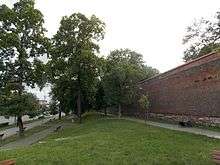
Several festivals are organised yearly in Sibiu, the most prestigious of them being the Sibiu International Theatre Festival, organized each spring at the end of May. Medieval Festival organized every year in August, reviving the medieval spirit of Transylvania. The Artmania Festival is held every Summer since 2006 and as of 2008 the Rockin' Transilvania Festival is also held in Sibiu. The oldest Jazz Festival in Romania is organized here, as well as the "Carl Filtsch" festival for young classical piano players, the "Astra Film" documentary film festival, the Transylvania calling Festival a Multi Cultural 6 day Open Air Music festival! 26–31 July 2007, a medieval arts festival and many more smaller cultural events.[45] Feeric Fashion Week is also hosted here. Sibiu was awarded by IGCAT (International Institute of Gastronomy, Culture, Arts and Tourism) to be part of the European Regions of Gastronomy program, event that will promote in 2019 the region's culinary heritage, multi-ethnic traditions and multi-cultural community.
European Cultural Capital
The designation as a European Cultural Capital for 2007, owed greatly to the excellent collaboration with Luxembourg, but also to what many regard as a miraculous social rebirth taking place in the city during the last years. The Cultural Capital status was expected to bring about an abrupt increase in quantity and quality of cultural events in 2007.
Administration
.jpg)
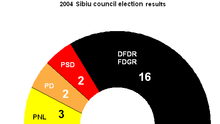
The city government is headed by a mayor.[46] Since 2014, the office is held by Astrid Fodor from the Democratic Forum of Germans in Romania (FDGR), who replaced Klaus Iohannis, the latter having become the 5th president of Romania. Iohannis, a Transylvanian Saxon, was mayor from 2000 to 2014, despite ethnic Germans nowadays making up less than 2% of Sibiu's population. Decisions are approved and discussed by the local government (consiliu local) made up of 27 elected councillors.[46] Sibiu is the capital of the Sibiu County.
| Party | Seats | Current Council | ||||||||||||
|---|---|---|---|---|---|---|---|---|---|---|---|---|---|---|
| Democratic Forum of Germans (FDGR) | 12 | |||||||||||||
| Social Democratic Party (PSD) | 6 | |||||||||||||
| National Liberal Party (PNL) | 5 | |||||||||||||
City districts
Sibiu is divided into the following districts:
- Historical center (divided into the Upper and Lower Town)
- Center (south-west of the historical center)
- Broscărie
- Dumbrăvii
- Gușterița (German: Hammersdorf)
- Hipodrom I, II, III, IV
- Lazaret
- Lupeni
- Piața Cluj (named after Cluj)
- Reșița (named after Reșița)
- Ștrand
- Terezian
- Tilișca
- Tineretului
- Trei Stejari
- Turnișor (German: Neppendorf)
- Țiglari
- Valea Aurie
- Vasile Aaron
- Veteranilor de Război
- Viile Sibiului
Some of them were villages annexed by the city as it grew, others were built as the city developed and increased its surface.
The ASTRA National Museum Complex and the Zoo, located in the south, also fall within city limits. The Păltiniș ski resort, located 35 kilometres to the south, is also administered by Sibiu.
Demographics
As of 2011 census data, Sibiu has a population of 147,245, a decrease from the figure recorded at the 2002 census,[16] making it the 14th-largest city in Romania. The ethnic breakdown was as follows:[47]
- Romanians 95.9%
- Hungarians 1.6%
- Germans (Transylvanian Saxons) 1.1%
- Roma 0.4%
A 2017 estimate placed the population at 169,316, a 14.98 percent increase since 2011. This increase brings Sibiu's population close to the numbers observed in 1992 when the highest population was recorded.[48]
Population dynamics
| Census[49] | Ethnic structure | ||||
|---|---|---|---|---|---|
| Year | Population | %± | Romanians | Hungarians | Germans |
| 1850 | 12,765 | — | 2,089 | 977 | 8,790 |
| 1880 | 19,446 | + 41.4% | 2,810 | 2,065 | 14,327 |
| 1890 | 21,465 | + 9.8% | 4,581 | 3,199 | 13,148 |
| 1900 | 29,577 | + 31.7% | 7,106 | 5,747 | 16,141 |
| 1910 | 33,489 | + 12.4% | 8,824 | 7,252 | 16,832 |
| 1920 | 32,748 | – 2.2% | 8,553 | 4,291 | 18,218 |
| 1930 | 49,345 | + 40.4% | 19,006 | 6,782 | 22,045 |
| 1941 | 63,765 | + 25.5% | 33,829 | 4,262 | 23,574 |
| 1948 | 60,602 | – 5% | 37,371 | 5,060 | 16,359 |
| 1956 | 90,475 | + 39.5% | 60,526 | 4,772 | 24,636 |
| 1966 | 109,515 | + 19% | 78,548 | 5,124 | 25,387 |
| 1977 | 151,005 | + 31.8% | 119,507 | 5,111 | 25,403 |
| 1992 | 169,610 | + 11.6% | 158,863 | 4,163 | 5,605 |
| 2002 | 154,892 | – 9% | 148,269 | 3,135 | 2,508 |
| 2011 | 147,245 | – 5% | 131,414 | 2,131 | 1,481 |
Population by religious denomination
Today, most of the population is Romanian Orthodox. Protestants and Roman Catholics represent about 5% of the population.
| Confessions in Sibiu | |||||||
| Confession | 1910 | 2002 | |||||
| Eastern Orthodox | 18% | 91% | |||||
| Greek-Catholic (Uniate) | 8% | 1% | |||||
| Roman Catholic | 20% | 2% | |||||
| Evangelical Lutheran | 42% | 2% | |||||
| Reformed | 7% | 1% | |||||
| Jewish | 4% | < 1 % | |||||
| Other | 1% | 4% | |||||
Economy
Sibiu is an important economic hub for Romania, with a high rate of foreign investments. It is also an important hub for the manufacturing of automotive components and houses factories belonging to ThyssenKrupp Bilstein-Compa, Takata Corporation, Continental Automotive Systems, Marquardt Group and NTN-SNR ball bearings. Other local industries are machine components, textiles, agro-industry, and electrical components (Siemens).
The city also contains Romania's second-largest stock exchange, the Sibiu Stock Exchange which is set to merge with the Bucharest Stock Exchange in 2018.[50]
The main industrial activities of Sibiu take place in two industrial zones located on the outskirts of the city:
- East industrial zone (East Economic Center), alongside the railway to Brașov and Râmnicu Vâlcea
- West industrial zone (West Economic Center),[51] near the exit to Sebeș, close to the Airport
A commercial zone located in the Șelimbăr commune plays an important role in the economy of Sibiu. It houses a mall and other large retailers.
Another factor that plays an important role in the economy of the city is tourism, which has been increasing at a steady rate since 2007.
Transport

Sibiu is well served in terms of transport and infrastructure. In 2010 a city bypass was opened, significantly reducing the road traffic inside the city.
Tursib[52] is the city's internal transportation system operator.
Air
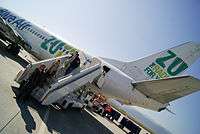
Sibiu International Airport is one of the most modern international airports in Romania, with direct connections to Germany, Austria, United Kingdom, Italy, Spain, France, Belgium, Denmark, Switzerland, and Israel.
Road
Sibiu is an important node in the European road network, being on two different European routes (E68 and E81). At a national level, Sibiu is located on three different main national roads, DN1, DN7 and DN14.
The Romanian Motorway A1 will link the city with Pitești and the Romanian western border, near Arad. From the remaining 332 km of motorway towards the border with Hungary Nadlac, a total of 276 km is completed and the last 56 km are currently under construction, while the timeline for the segment towards Pitești is targeted for completion for the year 2025 (construction will start no sooner than 2019). Sibiu' s ring road as part of A1 motorway was completed on 1 December 2010.
Sibiu is also an important hub for the international bus links with the biggest passenger transporter in Romania, Atlassib, based here. Transport companies are also providing coach connections from Sibiu to a large number of locations in Romania.
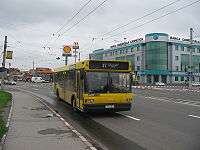
Rail
Sibiu is situated on the CFR-Romanian Railways Main Line 200 (Brasov – Făgăraș – Sibiu – Simeria – Arad – Romanian Western Border) and on Line 206 (Sibiu – Mediaș).
The city is served by five rail stations: the Main Station (Gara Mare), the Little Station (Gara Micǎ), Turnișor, Sibiu Triaj, Halta Ateliere Zonă . It has an important diesel-powered locomotives depot and a freight terminal.
Numerous Inter City trains (nicknamed Blue Arrows) connect Sibiu to other major cities in Romania: Cluj-Napoca, Brașov, Craiova, Timișoara and Bucharest.
Cycling
Over the last six years, Sibiu has enjoyed a revival of cycling. The bicycle way in the city span for 43 kilometers.
Bicycle rentals have offered a boost for the local economy with several small rental centers and a bigger rental center that is administered by the I'Velo Bike Sharing group.
Health

Sibiu is one of the important medical centers of Romania, housing many important medical facilities:
- County Hospital
- Academic Emergency Hospital;
- Hospital of Pediatrics;
- Military Emergency Hospital;
- CFR Hospital (Romanian Railways Hospital);
- "Dr. Gheorghe Preda" Psychiatry Hospital
- other smaller private clinics
The city also houses one of the largest private hospitals in the country, Polisano.
Education

Sibiu is an important centre of higher education, with over 23,000 students in four public and private higher institutions.[53][54][55][56]
The Lucian Blaga University of Sibiu was founded in 1990, with five faculties: Engineering and Sciences; Language Sciences; History and Law; Medicine; Food and Textile Processing Technology. Nowadays, there are 10 faculties and departments.
Sibiu also houses the Nicolae Bălcescu Land Forces Academy and the Military Foreign Language Center as well as two private universities, Romanian-German University and Alma Mater University.
In Sibiu there are 20 educational institutions on the secondary level, the most important of which are:
- Gheorghe Lazăr National College – sciences and informatics, first opened in 1692 as a Jesuit College
- Samuel von Brukenthal National College – German language high school
- Octavian Goga National College – social sciences, sciences, informatics and linguistics
- Onisifor Ghibu Theoretical Highschool – informatics, sciences, sports, theater and linguistics
- Andrei Șaguna National College – training for school teacher and linguistics
- Constantin Noica Theoretical Highschool – sciences and linguistics
- Daniel Popovici Barcianu Highschool – agricultural sciences
- George Baritiu National College – economic sciences
- Nicolae Iorga Elementary school
- Regina Maria Elementary school
Sports
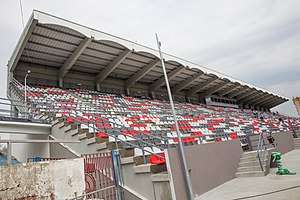
The city houses a football stadium, a multi-functional arena building (Sala Transilvania), a rugby court, a municipal pool and several private tennis courts.
Also, several sports international competitions are taking place every year: Sibiu Cycling Tour (in July), Red Bull Romaniacs Hard Enduro Rallye (around July), Sibiu Open (formerly held in September), Sibiu Rally (currently held in October).
Football
Sibiu has had a long football tradition, starting in 1913 with the founding of Șoimii Sibiu, which was the launchpad of Ilie Oană's career, who later became a star of FC Petrolul Ploiești. Later came Societatea Gimnastică Sibiu, a sport club of Sibiu's Transylvanian Saxon community, which's best performance was reaching the Divizia A final in the 1930-31 season. The best ever football team from Sibiu, based on performances, was Inter Sibiu, which had finished 4th after the 1990-91 season and had won the Balkans Cup during the same season. During the 21st century, the city has been represented by FC Sibiu and Voința Sibiu (of which only the latter has reached Liga I). Currently, FC Hermannstadt is the only major football team representing Sibiu.
Basketball
CSU Sibiu, one of the best Romanian basketball teams at the moment, represents Sibiu in the top tier of Romanian basketball, Liga Națională.
Handball
The city's handball team is called CSM Sibiu. Additionally, the nearby town of Cisnădie has a women's team in the first league, CS Măgura.
Rugby
- CSM Sibiu
Volleyball
- CSM Sibiu (men)
- CSS Sibiu (women)
Speed Skating
- CSS Sibiu
Natives
- Michael Gottlieb Agnethler, botanist
- Alexandru Apolzan, football player
- Arthur Arz von Straussenburg, Austro-Hungarian general
- Florin Barbu, bass player in Romanian bands Timpuri Noi and Proconsul
- Claudiu Baștea, judoka
- Ion Besoiu, Romanian actor
- Miklós Borsos, Hungarian sculptor
- Dan Burincă, Olympic artistic gymnast
- Andrei Codrescu, American writer
- Sabina Cojocar, Romanian gymnast
- Alexandru Curtean, football player
- Florin Diacu, Romanian-Canadian mathematician
- Steve Holmes, German pornographic actor
- Victor Iliu, Romanian film director
- Klaus Iohannis, 5th President of Romania
- Hermann Kusmanek von Burgneustädten, Austro-Hungarian general, see also Siege of Przemyśl
- Mircea Mureșan, Romanian film director
- Alexandru Mușina, Romanian poet
- Steliana Nistor, Romanian gymnast
- Hermann Oberth, space flight technology pioneer
- Nicolaus Olahus, Catholic archbishop of Esztergom
- Oskar Pastior, poet and translator
- Dan Perjovschi, Romanian artist
- Claudia Presecan, Romanian gymnast
- Erna Rubinstein, Hungarian violinist
- Iancu Sasul, Moldavian ruler
- Tobias Stranover, Transylvanian Saxon painter
- Jenő Szemák, Hungarian jurist
- Viorel Tilea, Romanian diplomat
- Melania Ursu, stage and film actress
- Radu Vasile, politician, Prime Minister of Romania
- Delia Velculescu, Romanian-American economist
- Adele Zay, Transylvanian-Saxon who established the kindergarten system in Hungary and then Romania
International relations
Twin towns
Sibiu has twinning agreements with:







.svg.png)




Consulates
The following countries have consulates in Sibiu:



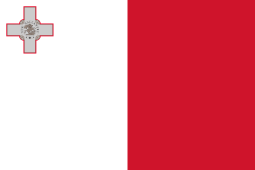
Gallery
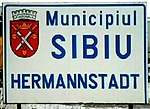 Bilingual Romanian-German sign at the entrance in Sibiu/Hermannstadt
Bilingual Romanian-German sign at the entrance in Sibiu/Hermannstadt Turnul Sfatului in Small Square
Turnul Sfatului in Small Square The Small Square of Sibiu, during Feeric Fashion Week closing gala - 2016
The Small Square of Sibiu, during Feeric Fashion Week closing gala - 2016 The Large Square during Christmas
The Large Square during Christmas
See also
References
- Heck, Pete. "The Romania Eyes". www.hecktictravels.com. Hecktic Travels. Retrieved May 2, 2020.
- "The City Where the Houses Do Not Sleep". www.wheretwogoto.com. Where Two Go. 2017. Retrieved May 2, 2020.
- Gheorghiță, Lavinia (January 3, 2019). "Sibiu or Seebiu?". www.rodiscover.com. RoDiscover. Retrieved May 2, 2020.
- "Results of the 2016 local elections". Central Electoral Bureau. Retrieved 3 April 2020.
- "Sibiu in the Lexico dictionary (powered by Oxford)". lexico.com. Oxford. Retrieved May 2, 2020.
- City Distance Tool Archived 2010-10-05 at the Wayback Machine at geobytes.com
- "Sibiu Cultural Capital Website". sibiu2007.ro. Archived from the original on 15 October 2006. Retrieved 28 April 2018.
- Beckett, Edward; Olson, Parmy. "In Pictures: Europe's Most Idyllic Places To Live". Forbes. Archived from the original on 2018-02-13.
- "Sibiu 2019 - European Regions of Gastronomy". europeanregionofgastronomy.org. International Institute of Gastronomy, Culture, Arts and Tourism (IGCAT). Retrieved May 2, 2020.
- "European Best Destinations". europeanbestdestinations.com. Retrieved May 2, 2020.
- Laicauf, Denisa (November 22, 2019). "Sibiu – Capitala Europeana a Drumetiei". Retrieved May 2, 2020.
- "Eurorando – Sibiu 2021". eurorando.eu. Retrieved May 2, 2020.
- "El Mundo – Best Christmas Markets in the World". elmundo.es. El Mundo. December 21, 2012. Retrieved May 2, 2020.
- Brooking, Francesca. "European Christmas Markets: Top 5". abouttimemagazine.co.uk. Retrieved May 2, 2020.
- "Conrad Haas' Flying Javelin". ancient-origins.net. December 4, 2017. Retrieved May 2, 2020.
- "Population as of 20 October 2011" (in Romanian). INSSE. 5 July 2013. Retrieved 5 July 2013.
- Roșu, Madalina (May 6, 2019). "2019 population estimate". oradesibiu.ro. Retrieved May 2, 2020.
- Victor Rouă (19 August 2015). "A Brief History Of The Transylvanian Saxon Dialect". The Dockyards. Retrieved 24 June 2020.
- Găină, Ramona (January 11, 2013). "Originea Numelui Sibiului". adevarul.ro. Adevarul. Retrieved May 2, 2020.
- "Sibiu on Britannica". britannica.com. Britannica. Retrieved May 2, 2020.
- "Hermannstadt (Sibiu) in Siebenbürgen". skr.de. Retrieved May 2, 2020.
- Hannover Moser, Birgitta Gabriela (2011). Siebenbürgen: Rund um Kronstadt, Schäßburg und Hermannstadt. Germany: Trescher Verlag. p. 107. ISBN 978-3-89794-157-1.
- Archived 2009-04-22 at the Wayback Machine
- "A szebeni városi nyomda". typographia.oszk.hu. Retrieved May 2, 2020.
- "Enciclopedia României". enciclopediaromaniei.ro. Retrieved May 3, 2020.
- "Sibiu Official Website – History". www.sibiu.ro. Primaria Sibiu. Retrieved May 3, 2020.
- Victor Rouă (3 October 2015). "The History Of The Transylvanian Saxons". The Dockyards. Retrieved 23 June 2020.
- Sibiu, or Hermannstadt? A Romanian City with German TraditionsPublished/Revised June 11, 2014 Archived January 4, 2016, at the Wayback Machine, europeupclose.com
- The vanished Romanian German community through Hitler's population transfer, soviet deportation, & mass emigration Archived 2016-03-16 at the Wayback Machine, expelledgermans.org
- The Saxons’ Land, or the Royal Domain (Fundus Regius) Archived 2015-07-15 at the Wayback Machine, alanier.at
- Columbia Lippincott Gazetteer of the World
- "World Weather Information Service – Sibiu". World Meteorological Organization. Archived from the original on July 26, 2017. Retrieved July 25, 2017.
- "CLIMAT summary for 15260: Sibiu (Romania) – Section 2: Monthly Normals". CLIMAT monthly weather summaries. Ogimet. Retrieved July 25, 2017.
- "AIR TEMPERATURE (monthly and yearly absolute maximum and absolute minimum)" (PDF). Romanian Statistical Yearbook: Geography, Meteorology, and Environment. Romanian National Statistic Institute. 2007. Archived from the original (PDF) on September 27, 2007. Retrieved July 9, 2015.
- "Sibiu Climate Normals 1961–1990". National Oceanic and Atmospheric Administration. Retrieved July 9, 2015.
- "Klimatafel von Hermannstadt (Sibiu), Siebenbürgen / Rumänien" (PDF). Baseline climate means (1961–1990) from stations all over the world (in German). Deutscher Wetterdienst. Retrieved November 23, 2016.
- Târgul de Crăciun din Sibiu Archived 2009-12-01 at the Wayback Machine
- "Christmas Traveling: 15 Of the Most Beautiful Christmas Markets in Europe". tourismontheedge.com. 7 December 2012. Archived from the original on 13 April 2014. Retrieved 28 April 2018.
- "Lexikon Katolikus". Retrieved May 6, 2020.
- WR. "The Bridge of Lies, Sibiu·". welcometoromania.ro. Archived from the original on 4 November 2013. Retrieved 28 April 2018.
- Radu Stanca National Theatre Archived 2006-09-09 at the Wayback Machine – Official Site
- State Philharmonic of Sibiu Archived 2012-11-20 at the Wayback Machine – Official Site
- Insider, Ro (17 January 2017). "Sibiu International Theater Festival becomes world's biggest". romania-insider.com. Archived from the original on 13 February 2018. Retrieved 28 April 2018.
- Klein, Konrad (October 17, 2014). "Eine Gräfin mit Herz". siebenbuerger.de. Retrieved May 3, 2020.
- 2006 Cultural Programme Archived 2006-05-01 at the Wayback Machine
- "Law no. 215 / 21 April 2001: Legea administrației publice locale" (in Romanian). Parliament of Romania. Retrieved 2008-03-12.
- "2011 census data" (PDF). insse.ro. Archived (PDF) from the original on 2 February 2017. Retrieved 28 April 2018.
- "Statistică: în șase ani Sibiul a crescut cu aproape 70.000 de locuitori | Turnul Sfatului Online". Turnul Sfatului Online (in Romanian). 2017-10-01. Archived from the original on 2015-05-26. Retrieved 2017-10-08.
- "Erdély etnikai és felekezeti statisztikája". varga.adatbank.transindex.ro. Archived from the original on 22 October 2007. Retrieved 28 April 2018.
- "Sbiu Stock Exchange Website". sibex.ro. Archived from the original on 25 December 2013. Retrieved 28 April 2018.
- "West industrial zone" (PDF).
- Tursib Archived 2007-05-22 at the Wayback Machine – Official Site
- ULBS, Departamentul de Comunicaţii și Marketing al. ":: L B U S :: About LBUS". www.ulbsibiu.ro. Archived from the original on 4 April 2015. Retrieved 28 April 2018.
- Land Forces Military Academy Archived 2015-01-30 at the Wayback Machine at mediafax.ro
- "Universitatea Romano-Germana din Sibiu". www.roger-univ.ro. Archived from the original on 19 February 2015. Retrieved 28 April 2018.
- "Istoricul Universitatii Alma Mater Sibiu – Universitatea Alma Mater Sibiu". www.uamsibiu.ro. Archived from the original on 4 May 2015. Retrieved 28 April 2018.
- (in Romanian) Sibiu Town Hall Official Site, Acordul de infratire intre Sibiu si orasul Deventer din Olanda Archived 2007-09-27 at the Wayback Machine, 23 May 2007
Bibliography
External links
| Wikimedia Commons has media related to Sibiu. |
| Wikivoyage has a travel guide for Sibiu. |
- Sibiu.ro: Official Sibiu Online website — tourism and history information and images. (in Romanian, English, and German)
- Turism.sibiu.ro: Official Sibiu Tourism website (in Romanian, English, and German)
- patrimoniu.sibiu.ro: Sibiu Heritage website (in Romanian and English)
- theFest.ro – Locuri si evenimente din Sibiu, Romania (in Romanian)
- RomaniaTourism.com: Sibiu — reference for surface area, population, etc. (2005).
- Sibiupeople.ro: Restoration of Historical Monuments in Sibiu —photo gallery and projects' report.
- Official Sibiu European Cultural Capital 2007 website (in Romanian, English, and German)
- The Diplomat: article; "Sibiu as Capital of Culture" (in Romanian)
- Rozylowicz.com: photos, videos, and retirement information
- Descopera.net: Sibiu in pictures
- Pictures of Sibiu
.jpeg)
